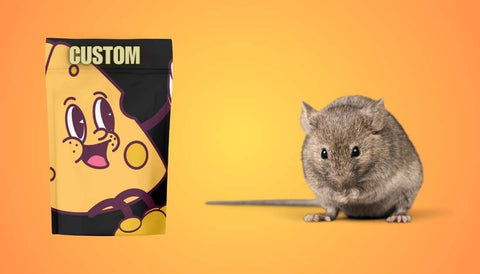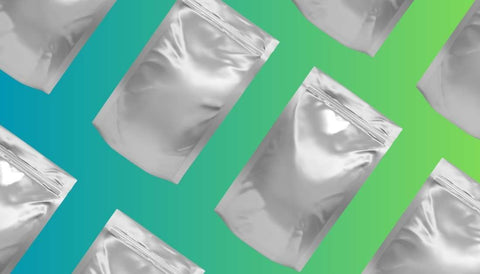When it comes to protecting your food from pests, understanding the capabilities of common rodents like mice is essential. Mice possess strong, sharp teeth that allow them to gnaw through a variety of materials, a fact that’s crucial when you’re considering the safety of food stored in Mylar bags. While Mylar bags are widely used for their durability and ability to preserve the contents within, it's important to consider their resistance to mice if you're planning to rely on them for food storage.
Mylar bags, known for their metalized coating, provide a barrier to light, moisture, and odors that can help extend the shelf life of food. However, your confidence in Mylar bags might be tested when faced with the persistence of mice. These rodents are determined when it comes to finding food sources and can chew through materials much tougher than one might expect.
Consequently, if you’re using Mylar bags to store food, you should be aware that they are not invulnerable to mice. As resourceful creatures, mice can and will chew through plastic and other materials. To enhance the security of your stored foods, you must be strategic about where and how you use Mylar bags, and you may need to consider additional protective measures to reinforce your storage solutions.
Understanding Rodent Behavior and Capabilities
You must be aware that rodents, especially mice, possess strong capabilities for chewing through various materials. This knowledge is crucial when considering the storage of your items.
Mice Chewing Mechanisms
Mice have constantly growing front incisors that allow them to gnaw through a variety of substances. These incisors have hard enamel on the front surface and softer dentin on the back, which sharpens the teeth as they grind together. This anatomy enables mice to chew incessantly without wearing their teeth down.
Common chewing targets include:
- Plastic bags: Thin, soft plastic is easily breached.
- Cardboard: Provides little resistance to mice.
- Wood: Although harder, mice can gnaw through over time.
- Steel wool**: Surprisingly, mice might be deterred by this material due to its hardness and sharp edges.
Materials Vulnerable to Rodent Damage
When examining materials prone to rodent damage, consider their composition. Materials like plastic and cardboard are no match for mice because they can be easily chewed through. Metal and glass, on the other hand, generally offer better protection against rodents due to their density and hardness. Here, the use of Mylar bags should be reconsidered as mice can pierce them, as evident from real-life experiences and testing.
Comparison of Material Resilience to Rodent Chewing:
| Material | Vulnerable to Rodents? | Notes |
|---|---|---|
| Plastic | Yes | Easily chewed through, especially softer types. |
| Cardboard | Yes | Offers little resistance to persistent chewing. |
| Wood | Yes | Can be penetrated over time, depending on its thickness. |
| Metal | Generally No | Only very soft metals can be chewed through. |
| Glass | No | Resistant to chewing due to hardness. |
| Steel Wool | No | Acts as a deterrent due to sharpness and hardness. |
Remember that while you may use tougher materials to deter mice, consistent and strategic deterrents are necessary for effective protection against rodent chewing capabilities.
Protecting Food Storage from Mice
When it comes to food storage, the reliability of your methods is as crucial as the food quality you're preserving. Mice are persistent pests capable of penetrating many types of food storage containers, so choosing and securing the right ones is key to keeping your pantry safe.
Mylar Bags and Rodent Prevention
Mylar bags are often used for food storage due to their durability and airtight qualities, which can prolong the shelf life of food. However, while Mylar is resistant to moisture and air, it is not immune to the gnawing teeth of mice. To enhance the mouse-proofing of your Mylar bags:
- Store Mylar bags inside sturdy plastic buckets that are more difficult for rodents to chew through.
- Consider using Mylar bags with thicker material; the thicker the Mylar, the harder it is for mice to bite through.
Alternative Rodent-Proof Containers
If you're seeking mouse-proof alternatives for food storage, you have options that go beyond plastic. Containers made from materials like metal, which mice cannot chew through, offer a higher level of security. For optimal protection:
- Select food-grade metal containers with tight-fitting lids.
- Ensure the metal containers are constructed without gaps or holes that could allow mice entry.
Effective Sealing Techniques
Achieving an airtight seal is not only vital for keeping food fresh but also for deterring mice. Proper sealing methods can prevent the scent of food from attracting these pests. Your sealing strategy should include:
- Utilizing strong seals, such as those created by heat sealers for Mylar bags.
- Checking regularly for any signs of wear or gap formation in the seals or containers.
- Employing tamper-proof lids or sealing mechanisms that are difficult for mice to navigate or dismantle.
Preventive Measures and Home Remedies
When dealing with mice, a proactive approach using natural repellents and strategic physical barriers ensures effective deterrence. Your objective is to make your space as uninviting as possible for these tenacious pests.
Natural Repellents and Deterrents
- Mint: Planting mint around your home can act as a natural barrier; mice typically avoid the strong scent.
- Peppermint Oil: Soak cotton balls in peppermint essential oil and place them in areas prone to mice. Refresh regularly to maintain efficacy.
- Cloves: These can be scattered in your pantry or stored with food as an additional repellant since mice dislike the odor.
Physical Barriers and Mouse-Proofing Strategies
Use these robust materials to fortify your storage and home:
-
Hardware Cloth:
- Material: Galvanized metal
- Mesh Size: 1/4 inch or smaller
Place this around potential entry points, such as vents or openings, and secure it firmly.
-
Copper Mesh or Steel Wool:
- Encase the perimeter of your home where gaps or holes are evident. Mice are less likely to chew through these metals due to their texture and taste.
-
- Consider transferring food from Mylar bags to sturdier containers made of thick plastic, glass, or metal to thwart chewing attempts.
By integrating these natural and structural tactics, you bolster your defenses, discouraging mice from taking up residence in your space.
Maintaining a Clean and Safe Household
To safeguard your food and maintain a clean environment, you must implement diligent storage and cleaning strategies. This prevents pest infestations and ensures that your food remains uncontaminated.
Food Preservation and Storage Best Practices
Choosing the Right Storage: To protect your food from mice, opt for food-grade plastic, metal, or glass containers with tight-fitting lids. Mice have been known to chew through Mylar bags and other plastics, rendering your efforts futile if you rely solely on these materials.
Sealing and Placement: Always seal your food properly. Utilize airtight containers and store them in cool, dry places. By prepping your food in this manner, you reduce the chances of attracting pests with the scent of the food.
Cleaning Protocols and Pest Control
Routine Cleaning: Keep your household clean by disinfecting surfaces regularly and promptly cleaning up crumbs and spills. Pay special attention to kitchen areas, as even small amounts of food debris can attract mice.
Pest Control: If you notice any signs of an infestation, such as mice droppings, contact pest control services immediately. They can provide professional advice and treatment options to address the issue.
Deploy traps around potential entry points and regularly inspect your home for any signs of unwanted guests. Staying proactive with these cleaning and pest control measures is key to maintaining a clean and safe household.



